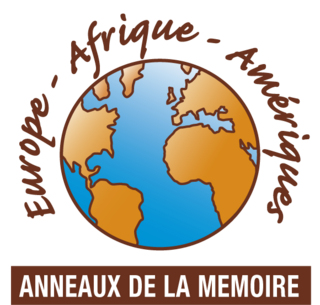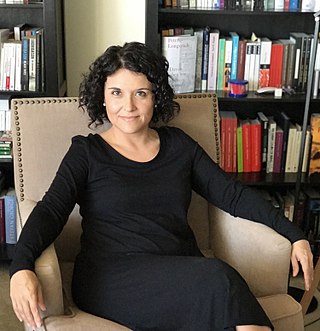Related Research Articles
Black is a racialized classification of people, usually a political and skin color-based category for specific populations with a mid- to dark brown complexion. Not all people considered "black" have dark skin; in certain countries, often in socially based systems of racial classification in the Western world, the term "black" is used to describe persons who are perceived as dark-skinned compared to other populations. It is most commonly used for people of sub-Saharan African ancestry, Indigenous Australians and Melanesians, though it has been applied in many contexts to other groups, and is no indicator of any close ancestral relationship whatsoever. Indigenous African societies do not use the term black as a racial identity outside of influences brought by Western cultures.
Racism is discrimination and prejudice against people based on their race or ethnicity. Racism can be present in social actions, practices, or political systems that support the expression of prejudice or aversion in discriminatory practices. The ideology underlying racist practices often assumes that humans can be subdivided into distinct groups that are different in their social behavior and innate capacities and that can be ranked as inferior or superior. Racist ideology can become manifest in many aspects of social life. Associated social actions may include nativism, xenophobia, otherness, segregation, hierarchical ranking, supremacism, and related social phenomena. Racism refers to violation of racial equality based on equal opportunities or based on equality of outcomes for different races or ethnicities, also called substantive equality.

The Atlantic slave trade or transatlantic slave trade involved the transportation by slave traders of enslaved African people, mainly to the Americas. The outfitted European slave ships of the slave trade regularly used the triangular trade route and its Middle Passage, and existed from the 16th to the 19th centuries. The vast majority of those who were transported in the transatlantic slave trade were from Central and West Africa who had been sold by West African slave traders to European slave traders, while others had been captured directly by the slave traders in coastal raids; European slave traders gathered and imprisoned the enslaved at forts on the African coast and then brought them to the Americas. Except for the Portuguese, European slave traders generally did not participate in the raids because life expectancy for Europeans in sub-Saharan Africa was less than one year during the period of the slave trade. Portuguese coastal raiders found that slave raiding was too costly and often ineffective and opted for established commercial relations.

The United Nations General Assembly declared 2004 as the International Year to Commemorate the Struggle against Slavery and its Abolition.

Île de Gorée is one of the 19 communes d'arrondissement of the city of Dakar, Senegal. It is an 18.2-hectare (45-acre) island located 2 kilometres at sea from the main harbour of Dakar, famous as a destination for people interested in the Atlantic slave trade.

Bagamoyo is a historic coastal town and capital of Bagamoyo District in the Pwani Region of Tanzania. Much of the settlement was founded at the end of the 18th century, though it is an extension of a much older Swahili settlement, Kaole. It was chosen as the capital of German East Africa by the German colonial administration and it became one of the most important trading ports for the Germans along the East African coast along the west of the Indian Ocean in the late 19th and early 20th century. Bagamoyo lies 75 kilometres north of Dar-es-Salaam on the coast of the Zanzibar Channel, across from the island of Zanzibar. The town hosts Bagamoyo Historic Town, that is a National Historic Site of Tanzania. In 2011, the town had 82,578 inhabitants.

The House of Slaves and its Door of No Return is a museum and memorial to the victims of the Atlantic slave trade on Gorée Island, 3 km off the coast of the city of Dakar, Senegal. Its museum, which was opened in 1962 and curated until Boubacar Joseph Ndiaye's death in 2009, is said to memorialise the final exit point of the slaves from Africa. While historians differ on how many African slaves were actually held in this building, as well as the relative importance of Gorée Island as a point on the Atlantic slave trade, visitors from Africa, Europe, and the Americas continue to make it an important place to remember the human toll of African slavery.

The history of slavery spans many cultures, nationalities, and religions from ancient times to the present day. Likewise, its victims have come from many different ethnicities and religious groups. The social, economic, and legal positions of slaves have differed vastly in different systems of slavery in different times and places.

The International Day for the Remembrance of the Slave Trade and its Abolition is an international day celebrated August 23 of each year, the day designated by UNESCO to memorialize the transatlantic slave trade.

The United Nations Slavery Memorial, officially known as The Ark of Return – The Permanent Memorial at the United Nations in Honour of the Victims of Slavery and the Transatlantic Slave Trade, is an installation at the Visitors' Plaza of the Headquarters of the United Nations in New York City, intended as a permanent reminder of the long-lasting effects of slavery and the Transatlantic slave trade. It was designed by Rodney Leon, a Haitian-American architect, and installed in 2015.

The organization Les Anneaux de la mémoire is an association under French law. Its objective is to make better known the history of the slave trade and slavery and their current consequences, in the perspective of making an experiment among many others, of work of memory whose theory remains to be done, in order to promote exchanges, balanced and equitable, between the societies of Africa, America and Europe. The Rings of Memory develop and implement exhibitions, publications, cultural actions at local and international level. Shared values and the search for scientific validity in its approach to historical, social and economic facts underlie all the association’s activities today. They are at the origin of multiple cultural actions, international conferences and symposia, publications, educational activities and numerous cultural and tourist development projects, in the framework of actions built with interlocutors from the three continents.

The Slave Route Project is a UNESCO initiative that was officially launched in 1994 in Ouidah, Benin. It is rooted in the mandate of the organization, which believes that ignorance or concealment of major historical events constitutes an obstacle to mutual understanding, reconciliation and cooperation among peoples. The project breaks the silence surrounding the slave trade and slavery that has affected all continents and caused great upheavals that have shaped our modern societies. In studying the causes, the modalities and the consequences of slavery and the slave trade, the project seeks to enhance the understanding of diverse histories and heritages stemming from this global tragedy.
Racism has been present in Brazil since its colonial period and is pointed as one of the major and most widespread types of discrimination, if not the most, in the country by several anthropologists, sociologists, jurists, historians and others. The myth of a racial democracy, a term originally coined by Brazilian sociologist Gilberto Freyre in his 1933 work Casa-Grande & Senzala, is used by many people in the country to deny or downplay the existence and the broad extension of racism in Brazil.

Reparations for slavery is the application of the concept of reparations to victims of slavery and/or their descendants. There are concepts for reparations in legal philosophy and reparations in transitional justice. Reparations can take many forms, including practical and financial assistance to the descendants of enslaved people, acknowledgements or apologies to peoples or nations negatively affected by slavery, or honouring the memories of people who were enslaved by naming things after them.

Ana Lucia Araujo is an American historian, art historian, author, and professor of history at Howard University. She is a member of the International Scientific Committee of the UNESCO Slave Route Project. Her scholarship focuses on the transnational history, public memory, visual culture, and heritage of slavery and the Atlantic slave trade.
International Day of Remembrance of the Victims of Slavery and the Transatlantic Slave Trade is a United Nations international observance designated in 2007 to be marked on 25 March every year.
The International Decade for People of African Descent, 2015–2024, was proclaimed by the UN General Assembly in a Resolution (68/237) adopted on 23 December 2013. The theme of the International Decade is "People of African descent: recognition, justice and development".

The Atlantic slave trade to Brazil occurred during the period of history in which there was a forced migration of Africans to Brazil for the purpose of slavery. It lasted from the mid-sixteenth century until the mid-nineteenth century. During the trade, more than three million Africans were transported across the Atlantic and sold into slavery. It was divided into four phases: The Cycle of Guinea ; the Cycle of Angola which trafficked people from Bakongo, Mbundu, Benguela and Ovambo; Cycle of Costa da Mina, now renamed Cycle of Benin and Dahomey, which trafficked people from Yoruba, Ewe, Minas, Hausa, Nupe and Borno; and the Illegal trafficking period, which was suppressed by the United Kingdom (1815-1851). During this period, to escape the supervision of British ships enforcing an anti-slavery blockade, Brazilian slave traders began to seek alternative routes to the routes of the West African coast, turning to Mozambique.

The Golden Rock African Burial Ground is an unmarked historical burial ground of enslaved African men, women and children located on the premises of the airport on Sint Eustatius, Dutch Caribbean in the ‘Cultuurvlakte’. The burial ground was part of the former Golden Rock plantation on the island.
References
- ↑ 2011 International Year for People of African Descent", UNCHR,
- 1 2 "History in dialogue on memories of the slave trade and slavery", UNESCO, August 22, 2011.
- ↑ Gina Thésée and Paul R. Carr, "The 2011 International Year for People of African Descent (IYPAD): The paradox of colonized invisibility within the promise of mainstream visibility", Decolonization: Indigeneity, Education & Society, Vol. 1, No. 1, 2012, pp. 158–180.
- ↑ "Culture: 2011, International Year for People of African Descent", UNESCO.
- ↑ "Calendar of events", 2011 International Year for People of African Descent, United Nations Human Rights.
- ↑ "Small Island Developing States: Just published: Islands as Crossroads - Sustaining Cultural Diversity in Small Island Developing States", UNESCO.
- ↑ "Equity, Justice, Development: People of African Descent in Latin America in comparative Perspective", Cartagena, Colombia, March 21 to 23, 2011.
- ↑ "Afro-Brazilian Arts and Cultural Heritage Festival Brings Music, Art, Dance, Film, and Food to Nation's Capital", CapoeiraDC Press release.
- ↑ "23 August: Teachers from three regions learn lessons about the slave trade", UNESCO.
- ↑ "UNESCO Slave Route project Launched in Saint Kitts and Nevis", UNESCO.
- ↑ "Return to Gorée: Remembrance of the Slave Trade and of its Abolition", UNESCO.
- ↑ "Discovering the Art of Boscoe Holder" Archived 2014-05-14 at the Wayback Machine , Trinidad Express Newspapers, 15 October 2011.
- ↑ "The Causes and Consequences of Racism", EMU Department of African American Studies, October 20, 2011.
- ↑ International Itinerant Photographic Exhibition “WoMen in Africa – NO COLOR ONE COLOR” by Ludovico Maria Gilberti, Fuoriserrone.
- ↑ " Africa...Mère de tous les peuples, une Célébration", Palais des Nations, 9 November 2011.